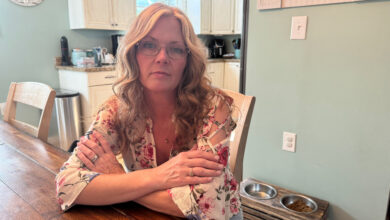
As covid-19 resurges across the country, driven by the highly infectious delta variant, experts are extending our understanding of the pandemic’s toll on older adults — the age group hit hardest by the pandemic.
New research offers unexpected insights. Older adults living in their own homes and apartments had a significantly heightened risk of dying from covid last year — more than previously understood, it shows. Though deaths in nursing homes received enormous attention, far more older adults who perished from covid lived outside of institutions.
The research addresses essential questions: Which conditions appear to put seniors at the highest risk of dying from covid? How many seniors in the community and in long-term care institutions might have died without the pandemic? And how many “excess deaths” in the older population can be attributed to covid?
Of course, it’s already known that older adults suffered disproportionately. As of Aug. 4, more than 480,000 people age 65 and older perished from covid — 79% of more than 606,000 deaths in the U.S. overall, according to the latest data from the Centers for Disease Control and Prevention. (This is likely an undercount because it relies on death certificate data that may not be up-to-date or accurately reflect the true toll of the virus.)
Still, new information about older adults’ vulnerabilities is useful as covid cases climb again and unvaccinated people remain at risk. Some key results from studies published over the past few months:
Death rates varied among groups of seniors. In a study published in Health Affairs in June, experts from the Department of Health and Human Services analyzed data for more than 28 million people with traditional Medicare coverage from February 2020 (the approximate start of the pandemic) to September 2020. (Excluded were about 24 million people in Medicare Advantage plans because data crucial to the study wasn’t available.) The researchers compared data for this period with previous years, dating to 2015.
The study examines deaths among individuals with covid and reaffirms headlines that have trumpeted the toll among older Americans. Medicare members diagnosed with covid had a death rate of 17.5% — more than six times the death rate of 2.9% for Medicare members who evaded the virus.
A notable finding in the study: Medicare members with dementia were especially vulnerable. If diagnosed with covid, their death rate was 32%, compared with nearly 14% for those with dementia who weren’t infected. Also at substantially increased risk of death from covid were older adults with serious and chronic kidney disease, immune deficiencies, severe neurological conditions and multiple medical conditions.
Most of the seniors who died of covid lived outside of nursing homes. The HHS experts’ study reported 110,990 “excess deaths” due to covid during the eight-month period it examined — most likely an undercount because many older adults who died may not have been tested or treated for the virus. The term “excess deaths” refers to a death count higher than the number expected based on historical data. It is a core measure of the pandemic’s impact.
Of the excess deaths HHS experts documented, 40% occurred in nursing homes but a larger portion, nearly 60%, were seniors living in other settings.
Other studies suggest far more excess deaths. Estimates of excess deaths in the older population vary widely depending on the period studied, the data sources used and the type of analysis conducted. Another study, published in May in the BMJ (formerly known as the British Medical Journal), calculated 458,000 “excess deaths” in 2020 in the United States. About 72% were people 65 and older, according to the British and American authors.
About two-thirds of these deaths can probably be attributed directly to covid, the authors noted. Others might be due to acute medical care that was delayed during the pandemic, poor management of chronic medical conditions, the effects of isolation and other factors.
Assisted living residents were significantly affected. Data about the impact of the pandemic on assisted living residents has been scarce, in part because these facilities are regulated by states, not the federal government. A study out in June in JAMA Network Open found the death rate for assisted living residents in 2020 — as the pandemic unfolded — was 17% higher than in 2019. In the 10 states with the greatest community spread of covid, the death rate for assisted living residents rose by 24%.
“Efforts must be made to support assisted living communities as they work to address infection prevention and control to keep their residents safe,” said Kali Thomas, a study co-author and associate professor of health services, policy and practice at Brown University.
Underlying medical conditions played a major role. A study by researchers from the Cleveland Clinic and the Health Data Analytics Institute in Dedham, Massachusetts, is one of the first to suggest how many older adults who caught covid would have died from underlying medical conditions even if the pandemic had not been underway. It, too, examined 28 million people with traditional Medicare coverage from the approximate start of the pandemic (the end of February) through November 2020. (Of 28 million people in the study, more than 2.4 % had a confirmed covid diagnosis and 10% had a “probable covid” diagnosis.)
Other studies estimate excess deaths by looking at population-wide data. This study looked at individual data, using a highly complex methodology to calculate a preexisting risk of death for each person based on his or her age, sex, medical conditions and other demographic characteristics. Actual deaths in 2020 were then compared with expected deaths based on those preexisting risks. The report has been published as a preprint without peer review.
About 4% of Medicare members with confirmed or probable covid who were living in the community, in their own homes and apartments, would have died anyway from underlying medical issues, the authors estimated. With covid, the actual death rate climbed to 7.5%.
In nursing homes and other long-term care facilities, 20.3% of residents diagnosed with confirmed or probable covid would have died due to underlying medical issues; with covid, that rose to 24.6%, the authors calculated.
“This is a more accurate picture of the true toll of covid,” said Dr. Daniel Sessler, chair of the department of outcomes research at the Cleveland Clinic. “As it turns out, the greatest increase in deaths [from the virus], in terms of both raw numbers and an increased risk of dying, was in the community, not in long-term care residents.”
The bottom line. About 80% of people 65 and older have been fully vaccinated, leaving millions of seniors still at risk of covid. Special attention should be paid to older adults with dementia and other serious neurological conditions, kidney disease and multiple medical conditions. Older adults, especially the eldest groups, who are frail and who live alone or with little support in areas where the virus is spreading rapidly also deserve special outreach and attention.
We’re eager to hear from readers about questions you’d like answered, problems you’ve been having with your care and advice you need in dealing with the health care system. Visit khn.org/columnists to submit your requests or tips.
KHN (Kaiser Health News) is a national newsroom that produces in-depth journalism about health issues. Together with Policy Analysis and Polling, KHN is one of the three major operating programs at KFF (Kaiser Family Foundation). KFF is an endowed nonprofit organization providing information on health issues to the nation.
USE OUR CONTENT
This story can be republished for free (details).


